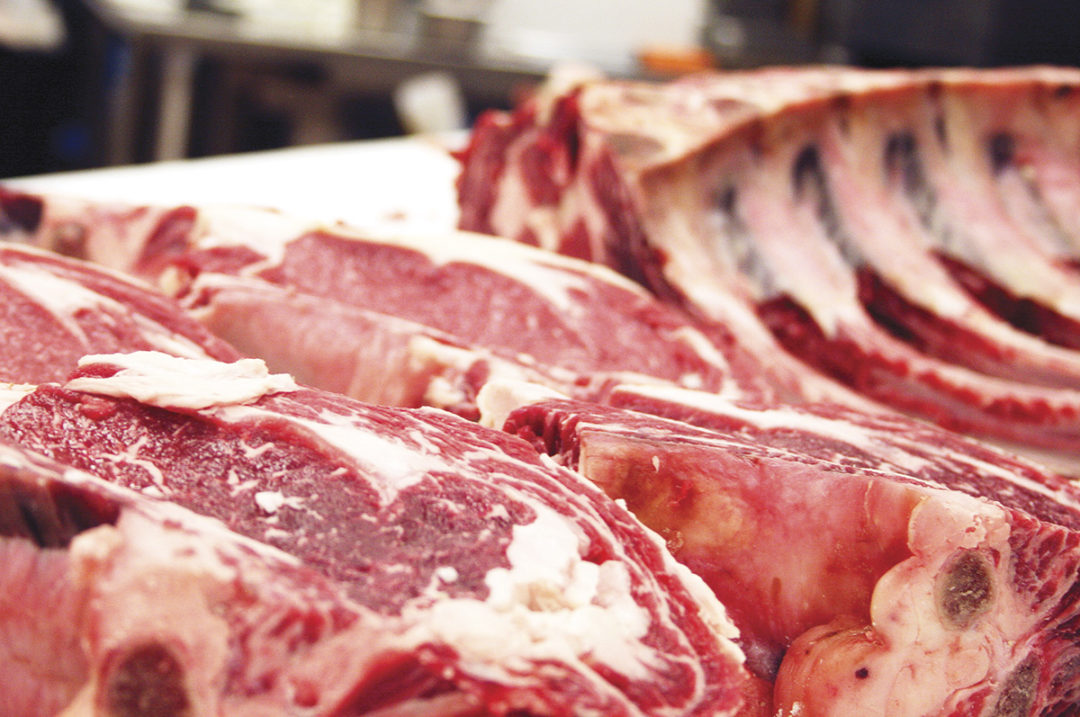Whether eating in a restaurant or cooking at home, we choose food items that taste good. The first requirement for a pleasant experience in eating a piece of meat is that it must be tender. If you encounter several tough steaks, you will probably lose interest in eating beef.
Since tenderness is a primary determining factor in whether people buy beef, a tremendous amount of research has been conducted on the subject. The producer now knows how to manage his herd to yield tender meat. Technology exists to measure tenderness. The relationship between marbling and tenderness has been extensively evaluated and marbling is a measurement used in grading beef carcasses. Nolan Ryan Tender Beef, Certified Angus Beef and certain other marketing organizations merchandize their product as tender products.
Another factor that makes eating beef a pleasurable experience is taste. A steak can be tender but if it doesn’t tantalize our taste buds, we don’t consider it appetizing.
Less is understood about taste than tenderness. Several universities are conducting research on the taste of beef and the database is growing. Dr. Rhonda K. Miller conducts research on the quality, quantity, safety and usefulness of meat and meat products through her appointment with the Texas Agricultural Experiment Station. She is currently researching the taste of beef.

Taste components
“We have completed two projects funded by the Beef Checkoff through the National Cattlemen’s Beef Association,” says Miller. “The objective of the first study was to identify the components of taste using an expert trained panel. The panel is able to taste food products and identify their components much like how wine tasters recognize floral, oak, pepper and other components of wine.”
The study was conducted in collaboration with Dr. Koushik Adhikari and Edgar Chambers IV at Kansas State University. Adhikari and Chambers teach graduate classes in sensory analysis and consumer behavior. They direct research projects in product evaluation and consumer understanding for national and international companies. Their expertise encompasses meat, grains, packaging materials, personal care, fabric, paper, pharmaceutical, paint finishes, fragrance and other consumer and industrial products.
An expert panel directed by Adhikari and Chambers developed a lexicon, or a dictionary of terms, for trained sensory panels to use in evaluating beef products. A partial list of flavors that occur in beef include beefy, brown-roasted, bloody or serumy (prevalent in meat cooked rare), fat-like, metallic, liver, green hay, animal hair, sweet, sour and barnyard.
Miller and others involved with sensory panels compared expected flavors in beef with standards developed by the American Society of Testing Materials. On her shelf, Miller has a huge reference book published by the sensory group listing flavors and references for each one. Each reference is rated on an intensity scale from 0 to 15. Zero is non-existent whereas 12 and up are considered intense flavoring.
For instance, the flavor references for metallic are 0.10 percent potassium chloride solution (intensity of 1.5), select strip steak (4.0) and Dole canned pineapple juice (6.0). The flavor reference for green hay is dry parsley (6.0) and for liver-like, it is Brauschweiger liver sausage (10.0). Panel members learn to recognize certain tastes by training on the appropriate lexicon.
Sensory panels also identify aromas of various foods by sniffing their volatile gases. There is a separate intensity scale for aromas than used for taste. For example, dry parsley has an aroma intensity of 5.0 and a taste intensity of 6.0. Each taste is defined in the reference book and sample preparation instructions are provided. The definition for green hay is, “brown/green dusty aromatics associated with dry grasses, hay, dry parsley and tea leaves.”

“Many different flavor components are found in beef, but most are at low levels,” says Miller. “The most common are beefy, brown/roasted and fat-like. It is assumed that when some of the flavor component levels become too high, the consumer doesn’t like the meat. Often people that regularly eat grass-fed beef think that grain-fed beef is tasteless. Grain-fed beef has flavor, but different components than found in grass-fed beef. Consumers who eat grass-fed beef are not familiar with these tastes.”
Grass-fed beef is lower in fat and tends to be more metallic, liver-like and bloody/serumy. It can be more beefy in taste depending upon how it is cooked. Grass-fed beef might have hay and grass flavors and sometimes chemical. Grass-fed beef consumers don’t mind these tastes because they are used to them. But people that primarily eat grain-fed beef may say they don’t like those tastes even though they probably can’t recognize the various components contributing to the taste.
Flavor is unique because it is tied to emotion. Miller says that when she is tired and stressed, she wants to go home and cook a pot roast with carrots, potatoes and onions. This is her comfort food because it reminds her of home in Colorado on a cold, windy winter day. The pot roast is tied to her emotions, as it is associated with calm and comfort.
Flavor also is more complicated when you add food concepts to the mix. As beef is used with other foods and different concepts, such as Thai, barbecue, Tex-Mex and many others, beef flavor can be altered through preparation. The method of cooking (grilled, roasted, fried, broiled), length of cooking (rare, medium, well-done) and seasoning all change the flavor of beef.
“Feedyards do a good job in removing variability in flavor,” states Miller. “It takes 70 days to alter the flavor of beef and cattle are usually fed at least that length of time. Beef flavor is standardized by finishing cattle on grain.
“Variability can occur in grass-fed beef because each forage species, stage of plant growth, moisture availability, soil type and temperature affect the taste. An example is cattle grazing on forage with high selenium content will transfer the taste to their meat.”
Additional studies
“In the first study we learned to identify the various taste components in beef,” says Miller. “We did a second study in which we identified the chemical drivers responsible for various taste and aroma components of beef.
“We just received funding for a third study that will connect the first two studies to the consumer. We are randomly selecting panels of beef eaters in Houston and Kansas City and at locations on the East and West coasts. These panels will be fed samples of the same beef prepared by the same methods to determine what they like and what they don’t like. A few people will be selected from each panel for one-on-one interviews in an attempt to better understand their desires for certain flavors. The objective of this study is to segment beef consumer groups by taste preferences.”
Research being conducted by Miller and her peers will aid beef producers in providing the products desired by consumers that will result in more demand.
Robert and Janelle Fears are freelance writers based in Texas.









